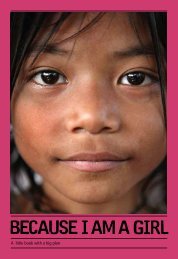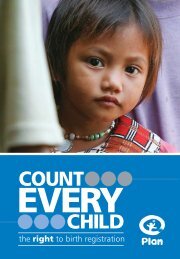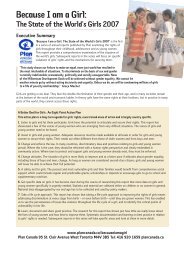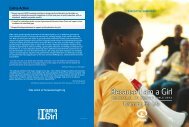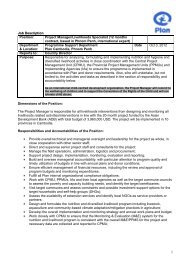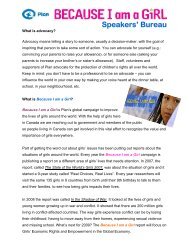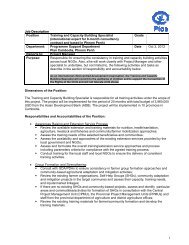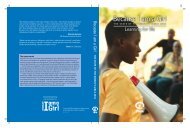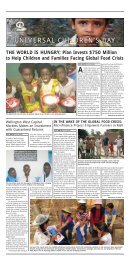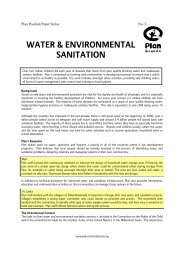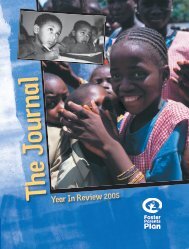Plan Worldwide Annual Review and Combined Financial ...
Plan Worldwide Annual Review and Combined Financial ...
Plan Worldwide Annual Review and Combined Financial ...
Create successful ePaper yourself
Turn your PDF publications into a flip-book with our unique Google optimized e-Paper software.
Disaster risk management<br />
<strong>Plan</strong>’s goal:<br />
Children <strong>and</strong> young people grow up safely in<br />
resilient communities <strong>and</strong> realise their right to<br />
protection <strong>and</strong> assistance in emergencies.<br />
Child-centred disaster risk reduction<br />
In times of disaster, children are particularly vulnerable. If they become separated from<br />
family <strong>and</strong> friends, they face uncertainty, anxiety <strong>and</strong> shock, with a significant impact<br />
on their emotional well-being. <strong>Plan</strong> promotes an innovative child-centred approach<br />
to Disaster Risk Reduction (DRR). This approach harnesses the potential <strong>and</strong> ideas of<br />
children <strong>and</strong> young people to make their lives safer <strong>and</strong> their communities more resilient<br />
to disasters. This work includes a variety of approaches such as:<br />
• working with children <strong>and</strong> youth groups to build awareness about risks <strong>and</strong> develop<br />
their capacities<br />
• promoting better management of DRR through strengthening the capacities<br />
of adults, education practitioners, communities, media <strong>and</strong> local government<br />
• working with ministries of education <strong>and</strong> national DRR agencies to develop<br />
school safety manuals, DRR curricula <strong>and</strong> teacher training modules<br />
• influencing governments to include children’s participation in DRR governance<br />
structures <strong>and</strong> decision-making processes.<br />
Building resilience in Dhaka<br />
People living in urban slums are often the first to suffer in a disaster <strong>and</strong> the last to<br />
receive help. In Dhaka, Bangladesh, where fires, floods <strong>and</strong> earthquakes are common,<br />
<strong>Plan</strong> is preparing communities to respond when disasters strike.<br />
One str<strong>and</strong> of work has involved running training sessions at eight schools in the city.<br />
In one, we worked with local authorities <strong>and</strong> volunteers to organise a mock<br />
neighbourhood drill involving 120 slum dwellers, students, teachers <strong>and</strong> street<br />
children. With support from the local fire service, participants learned about fire<br />
fighting, first aid <strong>and</strong> search <strong>and</strong> rescue. “I was rescued from the fourth floor<br />
with a rope, but I wasn’t scared,” says 12-year-old Lina. “I learned that you<br />
have to stay calm during an evacuation.”<br />
“ We have to build a disaster-resilient culture in every household,”<br />
says Anwar Shikder, Deputy Country Director of <strong>Plan</strong> Bangladesh.<br />
20<br />
© <strong>Plan</strong><br />
‹ Following Typhoon Sendong in the Philippines, <strong>Plan</strong> <strong>and</strong> partners set up<br />
emotional support sessions for children



